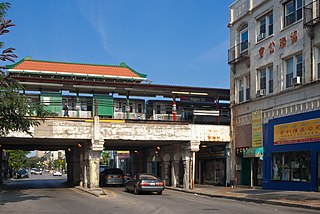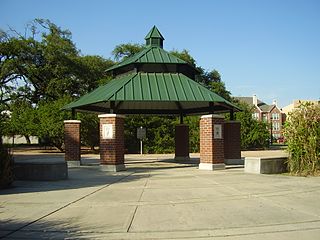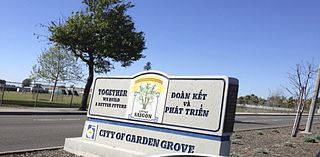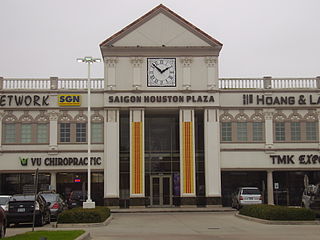
The Chinatown–International District of Seattle, Washington is the center of the city's Asian American community. Within the district are the three neighborhoods known as Chinatown, Japantown and Little Saigon, named for the concentration of businesses owned by people of Chinese, Japanese and Vietnamese descent, respectively. The geographic area also once included Manilatown.

The 13th arrondissement of Paris is one of the 20 arrondissements of the capital city of France. In spoken French, this arrondissement is referred to as treizième.

Chinatown is a community in Southwest Houston, Texas, United States.

Little Saigon is a name given to ethnic enclaves of expatriate Vietnamese mainly in English-speaking countries. Alternate names include Little Vietnam and Little Hanoi, depending on the enclave's political history. To avoid political undertones due to the renaming of Saigon to Ho Chi Minh City, it is occasionally called by the neutral name Vietnamtown. Saigon is the former name of the capital of the former South Vietnam, where a large number of first-generation Vietnamese immigrants arriving to the United States originate, whereas Hanoi is the current capital of Vietnam.

Shun Fat Supermarket is a Chinese Vietnamese American supermarket chain in the San Gabriel Valley region in California, Sacramento, California, San Pablo, California, Las Vegas, Nevada, Portland, Oregon and Garland, Texas.

Urban Chinatowns exist in several major European cities. There is a Chinatown in London, England, as well as major Chinatowns in Manchester, Birmingham, Newcastle and Liverpool. In Paris there are two Chinatowns: one where many Vietnamese – specifically ethnic Chinese refugees from Vietnam – have settled in the Quartier chinois in the 13th arrondissement of Paris which is Europe's largest Chinatown, and the other in Belleville in the northeast of Paris. Berlin, Germany has two Chinatowns, one in the East and one in the West. Antwerp, Belgium also has an upstart Chinese community.
The NW 39th Street Enclave, also known as "The Strip," "The Gayborhood," "May-Penn," "39th & Penn" or simply "39th Street" is a prominent lesbian, gay, bisexual and transgender (LGBT) district in Oklahoma City, Oklahoma. The area is located along NW 39th Street in the city's northwest quadrant, one block west of Pennsylvania Avenue.
City Heights is a dense urban community in central San Diego, California, known for its ethnic diversity. The area was previously known as East San Diego. City Heights is located south of Mission Valley and northeast of Balboa Park.
Oklahoma City is near the geographic center of the United States and is an integral point on the U.S. Interstate Network. The city is served by numerous roads and highways, toll roads, three major airports, a train station, a bus station, and a transit system.
The City of Oklahoma City uses Special Zoning Districts as a tool to maintain the character of many neighborhood communities.
Uptown is an area of Oklahoma City. It is often bounded by the northernmost edge of downtown Oklahoma to south, and Northwest 23rd Street to the north. The area is known for its upper-scale classical houses, its bar and nightlife district, and being a major cultural hub of Oklahoma City.
"SoSA" is the informal name of a small, inner-city neighborhood near downtown Oklahoma City. A website of the same name was developed by the architect and former resident who coined the term. SoSA is an acronym for "South of Saint Anthony", a reference to nearby St. Anthony Hospital. The name has not been accepted by a majority of the residents as an official designation, nor does the City of Oklahoma City use the term. Officially referred to as the "Cottage District" due to the number of quaint, old-fashioned homes in the area, SoSA is the name for the district used primarily by non-residents and real-estate agents.

West Argyle Street Historic District is a historic district in northern Uptown, Chicago, Illinois. It was listed on the National Register of Historic Places on June 3, 2010. The community covers an area of about 41 acres (0.17 km2); its rough boundaries are N. Glenwood Ave to the west, Winona Street to the north, Sheridan Road to the east, and Ainslie Street to the south.

Chinatowns are enclaves of Chinese people outside of China. The first Chinatown in the United States was San Francisco's Chinatown in 1848, and many other Chinatowns were established in the 19th century by the Chinese diaspora on the West Coast. By 1875, Chinatowns had emerged in eastern cities such as New York City, Boston, and Philadelphia. The Chinese Exclusion Act of 1882 barred Chinese immigration to the United States, but the Magnuson Act of 1943 repealed it, and the population of Chinatowns began to rise again. In the 2010s, the downturn in the U.S. economy caused many Chinese Americans to return to China.

This article discusses the history of Vietnamese Americans and Vietnamese immigrants in Houston, Texas, and its environs. Vietnamese immigration has occurred in Greater Houston, including Fort Bend County and Harris County, since 1975, after the Vietnam War ended and refugees began coming to the United States.

One of the largest Vietnamese neighborhoods in Philadelphia, United States is located in Passyunk Square, a neighborhood in South Philadelphia.

The Little Saigon district straddling the cities of Garden Grove and Westminster in Orange County, California is the largest Little Saigon in the United States. Saigon is the former name of the capital of the former South Vietnam, where a large number of first-generation Vietnamese immigrants originate.

Little Saigon, also popularly known as Vietnamtown or simply Viet-Town, is a neighborhood in Houston, Texas centered on Bellaire Boulevard west of Chinatown. It is one of the largest Vietnamese enclaves in the United States.
The Vietnamese American community in the Seattle, Washington area is home to a large Vietnamese population of more than 55,000 residents, which is about 1.5% of the metropolitan area's population. Much of the Vietnamese community lives in the Chinatown-International District, South Seattle, and the University District. Many Vietnamese arrived post-Vietnam War during the 1970s. Several thousand arrived at Camp Murray in the 1970s.











